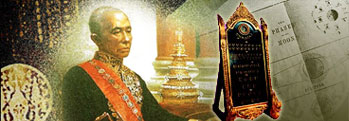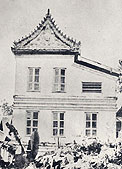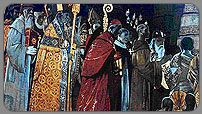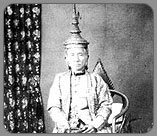The King Mongkut Studies Initiative
His Genius for Learning

Looking back at the histories of nearly every country in Asia, one observes a shared experience: colonial subjugation by Western imperial powers. Among them, Thailand stands alone—the sole nation in the region to have preserved its sovereignty throughout the colonial era. Though the kingdom was compelled to relinquish certain territories, its independence remained intact, a phenomenon deeply understood and proudly acknowledged by generations of Thai people. This collective pride in national independence would scarcely exist were it not for the wisdom and foresight of His Majesty King Mongkut (Rama IV)—a monarch of extraordinary intellect and statesmanship.
King Mongkut was endowed with remarkable aptitude for learning, nurtured over the twenty-seven years he spent as a Buddhist monk prior to his accession to the throne. Through years of dedicated study and contemplation, he accumulated deep knowledge, which he later applied in the realm of statecraft. His strategic diplomacy, rooted in understanding the global balance of power, enabled Siam to withstand the pressures of colonialism and avoid the fate that befell many neighboring nations. Simultaneously, he laid the foundation for modernization, positioning Siam as a nation worthy of respect in the eyes of the international community.
One of the most profound expressions of King Mongkut’s intellectual brilliance was in the realm of religious scholarship. In 1824 (B.E. 2367), he entered the monastic order at Wat Phra Si Rattana Satsadaram, following royal tradition. His monastic name, “Vajiranano”, meaning “One with diamond-like clarity and capability”, reflected the luminous depth of his insight. He resided primarily at Wat Samorai (later renamed Wat Ratchathiwat), where he devoted himself to the study of Vipassanā (insight meditation). He later undertook scriptural studies (kandhadhura) at Wat Mahathat, becoming fluent in the Pali language—reading, speaking, and writing with scholarly precision.
He became the first royal prince to pass formal examinations in Buddhist doctrine, eventually attaining the rank of Parian Ek (Senior Ecclesiastical Scholar), equivalent to nine levels in the Dhamma examinations. His deep mastery of the Tipiṭaka (Pali Canon), Atthakatha (commentaries), and Ṭīkā (sub-commentaries) enabled him to discern that many monastic practices then observed had drifted from the original Vinaya (discipline) prescribed by the Buddha. He thus initiated a reform of the Sangha, restoring strict discipline and revitalizing religious observance.
King Mongkut personally instructed and preached to both monks and laypeople, emphasizing the true essence of the Dhamma. He not only promoted scriptural study and monastic discipline, but also composed numerous Pali chants and liturgical verses that remain in use to this day. These include the Morning and Evening Chanting (Tam Wat Chao–Kham), Praise to the Triple Gem, the Eight-Fold Homage (Namo 8 Bot), the Ovada Patimokkha, Invocation of the Triple Gem, The Way to Liberation from Suffering, Sharing of Merits, Requesting the Dhamma, Uposatha Proclamation, and the Chant for the Full Moon and New Moon Days.
His royal compositions reflect not only literary elegance but also profound religious devotion and pedagogical intent, helping shape the spiritual consciousness of the nation.
Religious Learning

His Majesty King Mongkut (Rama IV) entered the Buddhist monkhood in accordance with ancient royal tradition at Wat Phra Si Rattana Satsadaram in 1824 (B.E. 2367). He remained ordained for twenty-seven years, bearing the monastic name “Vajiranano,” which translates as “He whose wisdom shines like a diamond.” He later resided at Wat Samorai (later renamed Wat Ratchathiwat) to pursue studies in vipassana (insight meditation). Subsequently, he undertook scriptural studies (kandhadhura) at Wat Mahathat, where he mastered Pali, the canonical language of Theravāda Buddhism. He could translate, speak, and write the language with fluency and scholarly precision.
He was the first prince in Siamese history to undertake the pariyatti examination in Buddhist doctrine, eventually passing the fifth level (prian 5) and later receiving royal conferment as a Parian Ek, equivalent to the ninth level, due to his exceptional mastery of the Tipiṭaka (Buddhist Canon), the Atthakatha (commentaries), and the Tika (sub-commentaries). Through these studies, he came to realize that the monastic practices of the time had diverged from the original Vinaya (discipline) as laid down by the Buddha. Consequently, he sought to reform and restore the Sangha, correcting lax observances and reestablishing doctrinal accuracy. He personally instructed and preached to monks and laypeople, emphasizing the essence of the Dhamma, and teaching both Buddhist doctrine (pariyatti) and disciplinary practice (patipatti).
Moreover, King Mongkut composed numerous Pali verses and liturgical texts, many of which are still in use today. Among his royal compositions are the Morning and Evening Chanting (Tam Wat Chao–Kham), Homage to the Triple Gem, the Eight-Fold Homage (Namo 8 Bot), the Ovada Patimokkha, Invocation of the Triple Gem, The Path to Liberation, Sharing of Merits, Requesting the Dhamma, Uposatha Day Proclamation, and chants for the Full Moon and New Moon Days. His legacy in religious reform and scholarship remains one of the most enduring aspects of his reign—shaping the intellectual and spiritual landscape of Thai Buddhism into the modern era.
Understanding the Sufferings and Well-being of the People
While ordained as a Buddhist monk, His Majesty King Mongkut (Rama IV) undertook pilgrimage journeys (thudong) to venerate great stupas in various provincial cities. These travels offered the people an unprecedented opportunity to encounter him closely and personally. As he was then a monk, the King preached the Dhamma and provided moral instruction, helping the people better understand and embody the principles of Buddhist ethics and virtue. His presence as a religious teacher created an atmosphere of trust and reverence, in which the common people felt encouraged to openly express their hardships and well-being. Upon ascending the throne, His Majesty continued this tradition of engagement by undertaking royal journeys to the provinces, further strengthening his understanding of his subjects and their conditions throughout the kingdom.
During his provincial journeys, His Majesty King Mongkut (Rama IV) closely observed the landscape, natural resources, and forest abundance, while also visiting remote communities. These experiences allowed him to gain a genuine understanding of the living conditions, needs, and hardships of his people. He became aware of numerous social issues, such as the pollution of rivers and canals, widespread debt, the selling of daughters, addiction to vice, and unjust practices such as banning close royal audiences, the beating of petitioners before accepting appeals, and the collection of market taxes, among others.
His Majesty used these direct observations as the basis for administrative reform and compassionate intervention. He implemented measures aimed at alleviating hardship and improving the well-being of his subjects, thereby contributing to the kingdom’s progress. Notable examples include the abolition of market tolls, personally receiving petitions (kho dika), granting royal permission for the people to approach him closely, and allowing subjects to wear upper garments when presenting themselves before the King—a symbolic act that affirmed their dignity and equality under royal protection.

His Majesty drew upon the firsthand knowledge he acquired during his travels as the basis for policy reform and humanitarian action, aiming to ensure the well-being of his subjects and promote the development of the nation. Notable reforms included the abolition of market tolls, personally receiving petitions, granting royal permission for subjects to approach him in close audience, and allowing them to wear upper garments while in his presence—a gesture of dignity and compassion that bridged the distance between monarch and people.
His Majesty also undertook extensive royal journeys across all regions of the kingdom. In the North, he traveled as far as Sukhothai; in the South, to Pattani; in the East, to Trat; and in the West, to Kanchanaburi, among other locations. These provincial tours were not merely ceremonial—they represented a direct and empathetic engagement with the lives of his people, particularly in remote and underserved areas.
King Mongkut’s royal journeys thus became the prototypical model for the later informal travels of King Chulalongkorn (Rama V)—known as Prabass Ton—and have continued to inspire the royal practice of visiting rural communities as exemplified by His Majesty the present King, who has similarly prioritized personal contact and public service in all regions of the country.
Learning in Collaboration with Western Clergy

Christian clergy and missionaries had been active in Thailand since the Ayutthaya period, arriving to propagate their faith. Many of these individuals, however, possessed expertise beyond theology. Their contributions extended into linguistics, medicine, science, and astronomy. Notable among them were figures such as Dr. Dan Beach Bradley, known to the Siamese as Mo Bradley, and Bishop Jean-Baptiste Pallegoix, who played vital roles in Thailand’s development.
As Western influence in Siam grew and requests for treaties increased, King Mongkut recognized the necessity for his people to learn foreign languages to engage effectively with foreigners. During his monastic life, His Majesty resided at Wat Samorai (later Wat Rachathiwat), which was situated near the Khmer Church—Wat Conception—where he became well-acquainted with Bishop Pallegoix. The King and the bishop regularly exchanged knowledge: His Majesty instructed Pallegoix in Pali, Thai language, customs, and Siamese traditions, while the bishop taught him Latin and Western social norms. When Pallegoix compiled his Thai-language lexicon, Sapphapachanapasathai, it is believed the King lent assistance and guidance in its creation.
When a Siamese diplomatic mission was dispatched to establish relations with Napoleon III of France and Pope Pius IX at the Vatican, His Majesty once again benefited from Bishop Pallegoix’s support in matters of language and diplomacy.
Later, while residing at Wat Bowonniwet, King Mongkut studied English with Dr. Jesse Caswell, referred to by Siamese as Mo Haskan. His Majesty took lessons four days a week, one hour per day. These sessions were not limited to language acquisition but encompassed intellectual exchanges, during which books, treatises, and ideas were shared. His Majesty posed numerous questions and delved deeply into discussion, thus acquiring broad knowledge across diverse disciplines including geography, physics, chemistry, mathematics, astronomy, history, and Western political systems.
Eager to deepen his studies, His Majesty ordered books, manuals, instruments, and scientific apparatus from abroad for experimentation and self-instruction. As a result of these dedicated efforts, he attained remarkable proficiency in astronomy, culminating in his precise prediction of a total solar eclipse two years in advance—a feat that garnered the respect of both local and foreign scholars.
Learning from Neighboring Countries

King Mongkut was acutely aware of the threats posed by the Western imperial powers, for His Majesty diligently followed the flow of information and developments occurring in the neighboring countries at all times.
Through newspapers and foreign publications—both those He personally acquired and those presented to Him—His Majesty King Mongkut constantly enriched His understanding. He also engaged in the exchange of knowledge with foreign nationals. Thus, He came to the realization that although the nations of Asia, including Siam, might have no desire to engage in commerce or diplomacy with Western powers, the era in which they lived was one of imperial expansion, dominated by military might and overwhelming force. In such an age, resistance, rejection, or national isolation would yield no benefit whatsoever.
For instance, Japan—despite having closed itself off to the world for many years—was eventually compelled to sign the Treaty of Kanagawa and open its ports to the United States. Burma resisted and waged war against the British, only to lose its independence. Vietnam fell under French dominion. Even China, India, and Sarawak were ultimately brought under British control. These realities were not lost on His Majesty King Mongkut, who studied them closely and used such knowledge to inform His decisions. He understood that Siam, being a relatively small kingdom, must adopt a policy of strategic accommodation—yielding where necessary, yet always with a view to preserving sovereignty and independence. This gave rise to a delicate balance-of-power diplomacy, aimed at preventing any one foreign power from dominating.
At the same time, Western imperial powers began encroaching on Siam’s tributary territories—Cambodia, Laos, and the Malay Peninsula—further heightening the urgency to modernize and reform the kingdom, lest those foreign nations use Siam’s perceived “backwardness” as a pretext for colonization.
Thus, His Majesty wisely chose to amend existing treaties at the behest of British envoys, including the painful concession of extraterritorial rights and the decision to open the country to foreign trade and influence. Yet He did so with full awareness and astute judgment, ensuring that Siam maintained its sovereignty, independence, and national dignity. This course of action—pragmatic yet principled—stands as a testament to His foresight and deserves the highest admiration and praise.
The Promotion of Learning

It is widely acknowledged that His Majesty King Mongkut was a sovereign deeply devoted to the lifelong pursuit of knowledge. Throughout His reign and indeed His entire life, He held learning in the highest regard—most notably the study of languages, which He considered a vital conduit for understanding the world. His Majesty diligently acquired proficiency in English, Pali, and French, recognizing that language is the gateway through which one gains access to broader realms of knowledge, diplomacy, and cross-cultural understanding.
His Majesty was the only monarch in all of Asia who could read, write, and speak the English language, which enabled Him to remain well-informed of global affairs and to apply such knowledge in matters of royal judgment. Through His mastery of foreign scholarship, He endeavored to elevate the standing of the Kingdom of Siam among the community of civilized nations. Recognizing the vital importance of the English language, His Majesty placed great emphasis on its study.
Thus, during His monastic years, the King actively encouraged Buddhist monks, members of the royal family, and high-ranking officials to study English. He arranged for them to receive instruction from Dr. Jesse Caswell, known among the Siamese as “Moh Hat-kan”, an American missionary and scholar who had earned His Majesty’s trust and respect.
Upon His accession to the throne, His Majesty commissioned Mrs. Bradley and Mrs. Mattoon, wives of American missionaries, to provide instruction in the English language, Western literature, and modern sciences to His royal daughters and the ladies of the inner court. This marked a significant opening of educational opportunities for women within the royal household.
Subsequently, His Majesty employed Mrs. Anna Leonowens and Dr. J.H. Chandler (referred to by the Siamese as “Dr. Chandale”) to serve as instructors of the English language to both princes and princesses. These lessons were conducted within the Grand Palace, and notably, instruction was delivered entirely in English, without translation into Thai, enabling the royal children to acquire the language in a natural and immersive manner. As a result, they became capable of composing correspondence and recording official documents in English.
Furthermore, in order to extend such educational opportunities to His subjects, His Majesty encouraged Christian missionaries to establish schools in Bangkok and the provinces. This initiative coincided with the printing of vernacular textbooks, such as Chindamani, Prathom Ka-Kor, Prathom Mala, and texts in practical disciplines including mechanical arts and medicine. These developments greatly enhanced the access to modern knowledge for commoners, and marked the broadening of learning opportunities beyond the royal court.
In addition, His Majesty sponsored the overseas study of certain noblemen and officials, dispatching them to foreign lands to observe advanced knowledge and acquire modern expertise, with the aim of applying such wisdom to the progress and development of the Kingdom of Siam.
Bibliography
Kraisri Nanaa. King Mongkut: Foreseeing the West, “Friendship Laced with Poison”. Bangkok: Matichon, 2004, p. 23.
Khajon Sukpanich. Historical Data: The Bangkok Period. Bangkok: Department of History, Srinakharinwirot University, Prasarnmitr, 1975, p. 225.
Dhammasapha and Banlue Dhamma Institute. Royal Dharma and the Religious Deeds of King Mongkut. Bangkok: Dhammasapha, 1999, pp. 73–74, 123.
Mom Chao Poonpisamai Diskul. What I Have Witnessed. Bangkok: Media Focus Co., Ltd., 1991, pp. 125–126.
Phra Thepmongkonsuthee. King Mongkut and Buddhism: Royal Biography and Essays. Bangkok: Chulalongkorn University Press, 2004, p. 30.
Mom Chao Pornpimolpan Ratchanee. The Royal Letters of King Mongkut Prior to His Accession to the Throne, 1932, p. 2.
Mom Luang Manich Jumsai. The Crown and the British. Bangkok: Chalermnit Bookstore, 2002, p. 28.
Wilailak Thavornthanasarn. Thai Elites and the Adoption of Western Culture. Bangkok: Muang Boran Publishing House, 2002, pp. 81–82.
Pensri Duke. Foreign Affairs and the Sovereignty of Thailand. Bangkok: Text & Journal Publication Co., Ltd., 2001, pp. 3–4.
Siwisi Puphet. Records of Siamese International Relations with Foreign Nations, Vol. 7 (1854–1855). Bangkok: Department of Fine Arts, 1997, p. 25.
Sukonrat Chansak. Various Historical Matters from Foreign Documents. Bangkok: Department of Fine Arts, 1996, pp. 112–115.
S. Phlainoi. King Mongkut of Siam. Bangkok: Pappim Press, 2001, p. 56.
Phra Siam Thuranu Raksa. The Kingdom of Siam. Bangkok: Tonchabap, 2000, pp. 89–90.
Sukanya Sudbanthat. Dr. Bradley and the Origins of the Newspaper in Siam. Bangkok: Matichon, 2004, pp. 19–23.
Suthon Khwannakhon. King Mongkut of Siam: The Fourth Reign Sovereign of Siam. Bangkok: 15 Meena Publishing, n.d., p. 80.
Suwan Phetcharnil. The Dawn of the Thai People in the Scientific Age. Bangkok: Religion Printing House, 2002, p. 61.
Suwan Phetcharnil. Chompin, the Father of Thai Science – 196 Years of Prince Pinklao. Bangkok: Religion Printing House, 2004, p. 212.
Commemorative Volume of Wat Ratchapradit Sathitmahasimaram on its 108th Anniversary (26 November 1864 – 26 November 1972). Bangkok: n.p., 1976, p. 9.
Anek Nawikamun. Farangs in Siam. Bangkok: Saengdao Publishing, 1999, pp. 38–39.
Moffat, Abbot Low. Mongkut the King of Siam. New York: Cornell University Press, 1962, pp. 20–21.

